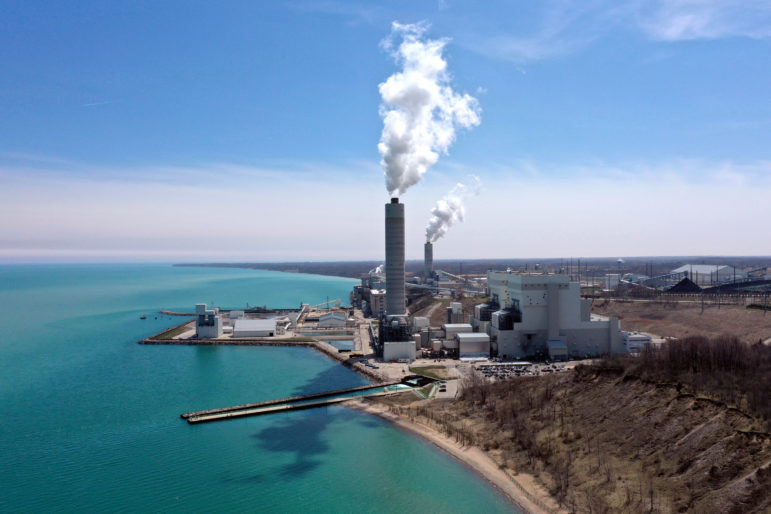EPA Considering Stricter Air Pollution Standards
Advocates, elected officials call for strongest possible controls.

The plants, in Oak Creek, Wis., near Milwaukee, are coal-fired electrical power stations. Coburn Dukehart/Wisconsin Watch
Elected officials in Milwaukee and Wisconsin health groups are pushing the Biden administration to strengthen federal air quality standards to reduce pollution from power plants, including two in southeastern Wisconsin.
The request comes as the Environmental Protection Agency is seeking to revoke a 2020 finding by the Trump administration that affects regulation of mercury and hazardous air toxics from power plants, which are a major source of that pollution. Under former President Donald Trump, the EPA weakened the rule that required significant reductions of mercury and other harmful emissions.
Milwaukee County Board Chair Marcelia Nicholson said air pollution from power plants must be addressed to achieve racial equity, including the Oak Creek and Elm Road plants in southeastern Wisconsin. Nicholson said communities of color more often suffer severe health setbacks from pollution, noting the county declared racism a public health crisis in 2019.
“These communities are disproportionately impacted by these health conditions, such as asthma, because they often live in regions with the most polluted air and near dirty power plants,” Nicholson said.
Around 68 percent of Black people live within 30 miles of a power plant, according to a 2011 report from the national Natural Resources Defense Council.
“Burning fossil fuels has created a global public health crisis,” Gervais said. “It’s critical that the EPA implement the strongest possible standards on polluters and replace these coal-fired power plants with renewable energy.”
She added coal plants account for 30 percent of carbon emissions in the energy sector.
Milwaukee-based WEC Energy Group, parent company of We Energies, plans to shut down it Oak Creek power plant by 2024 as it aims to drop coal from its power mix by 2035. The company also plans to transition its two coal-fired units at the Elm Road Generating Station to natural gas.
The company has set a goal to go carbon-neutral by 2050 in line with Gov. Tony Evers’ goal, and it’s investing $5.4 billion in wind, solar and battery storage by 2026.
We Energies spent roughly $875 million to install pollution controls to reduce emissions of nitrogen oxide and sulfur dioxide to meet requirements under the Clean Air Act. The utility said the air quality control project completed in 2012 cut emissions of sulfur dioxide by more than 90 percent and nitrogen oxide emissions by more than 70 percent.
State Sen. Chris Larson, D-Milwaukee, said he celebrated We Energies’ plans to shut down its Oak Creek coal plant, but he remains skeptical the utility will follow through on its announcement until the plant is retired.
In 2012, the EPA found under the Obama administration that it was “necessary and appropriate” to regulate hazardous air pollutants like mercury from power plants. The proposed rule, if finalized, would revoke the Trump administration’s 2020 finding that undermined the agency’s ability to control emissions from coal-fired power plants.
The agency is holding a virtual public hearing at 9 a.m. Central Time on Thursday to accept comments on its proposed rule to build on its existing Cross-State Air Pollution Rule. If approved, the agency would impose a pollution limit or emissions budget during the ozone season for each of the states covered by the rule as early as next year.
Listen to the WPR report here.
Wisconsin elected officials, health groups seek stronger standards to reduce air pollution from power plants was originally published by Wisconsin Public Radio.
If you think stories like this are important, become a member of Urban Milwaukee and help support real, independent journalism. Plus you get some cool added benefits.






















helpful for your readers if you included that in 2016, prior to Trump being President, the US Supreme Court ruled that the EPA failed to include cost as a factor (as required by law) when the EPA issued their 2012 regulations. A specific concern was how much the new regs would increase the monthly electric bills of consumers.
Journalism can regain tons of credibility when journalists outgrow their “Obama / Trump is the source of every problem in America” spin on every story, while neglecting to include the relevant facts of the article.
The EPA has been in litigation since 1990 on this case. I’d love to see a piece covering how much money the EPA has been spent during those 32 years for this never ending boondoggle to pay for the studies & attorneys. That money could have been spent on actually providing Healthcare or improved housing choices to those that were/are impacted.